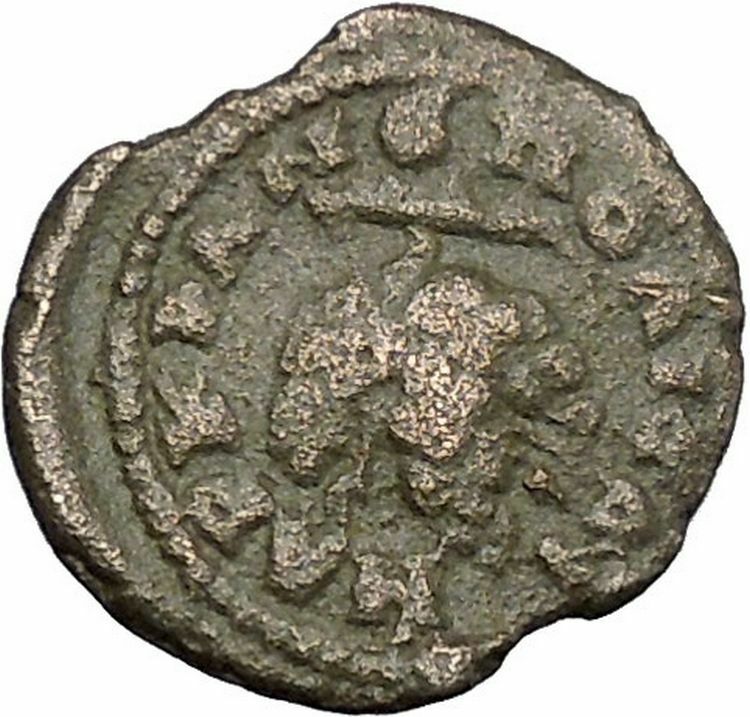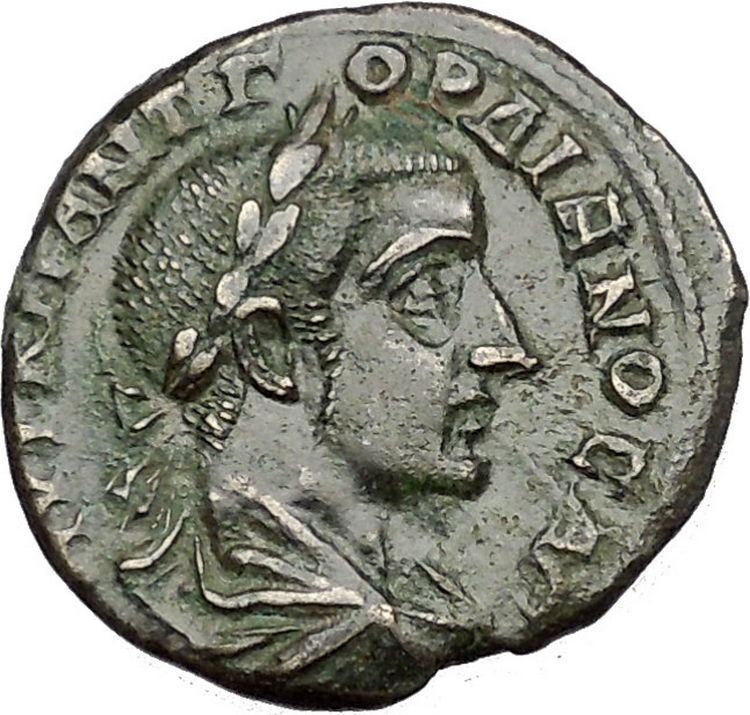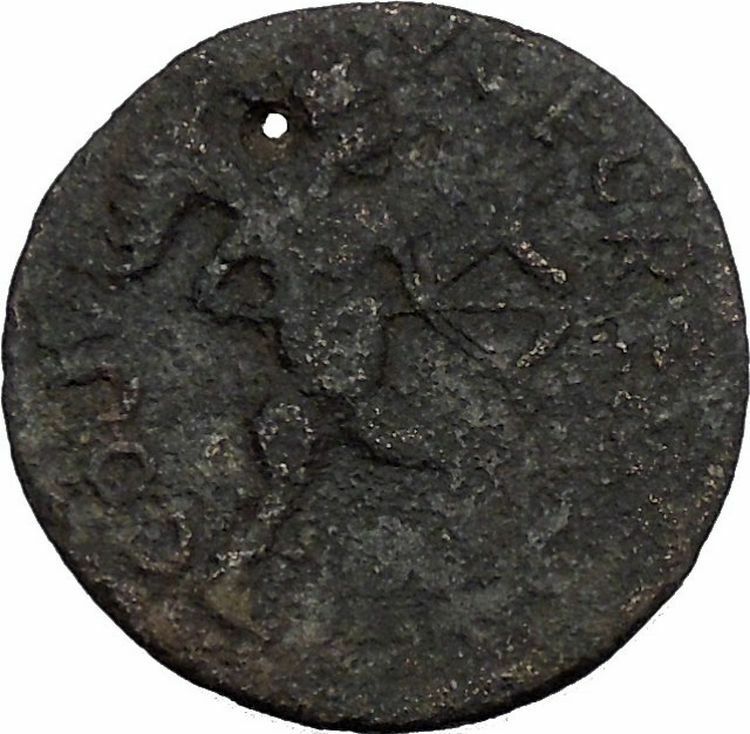|
–
Roman Empress Wife of
Emperor
Severus Alexander
222-235 A.D. –
Bronze 25mm (11.86 grams) of
Pella in
Macedonia
Reference: SNG Copenhagen 232; SNG ANS -.
IVLIA MAMAEA AVG, Diademed and raped bust
right.
COL IVL AVS PЄLLA, Pan seated left on rock, the right arm around
his head and holding lagobolon in his left arm; in left field, large syrinx.
You are bidding on the exact item pictured,
provided with a Certificate of Authenticity and Lifetime Guarantee of
Authenticity.
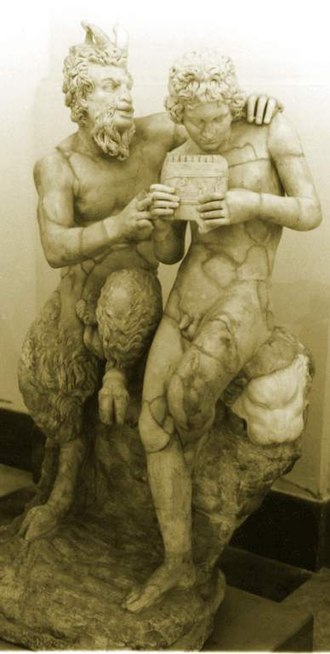
In
Greek religion
and
mythology
,
Pan is the god of the
wild, shepherds and flocks, nature of mountain wilds, hunting, and
rustic music
, and companion of the
nymphs
. His name originates within the
Ancient Greek
language, from the word paein
(πάειν), meaning “to pasture.” He has the hindquarters, legs, and horns of a
goat, in the same manner as a
faun or satyr
. With his homeland in rustic
Arcadia
, he is also recognized as the god of
fields, groves, and wooded glens; because of this, Pan is connected to fertility
and the season of spring. The ancient Greeks also considered Pan to be the god
of theatrical criticism.
In
Roman religion and myth
, Pan’s counterpart was
Faunus
, a nature god who was the father of
Bona Dea
, sometimes identified as
Fauna
; he was also closely associated with
Sylvanus
, due to their similar relationships
with woodlands. In the 18th and 19th centuries, Pan became a significant figure
in the Romantic movement
of western Europe and
also in the 20th-century
Neopagan movement
.
An area in the
Golan Heights
known as the Panion or Panium is
associated with Pan. The city of
Caesarea Philippi
, the site of the
Battle of Panium
and the
Banias
natural spring, grotto or cave, and
related shrines dedicated to Pan, may be found there.
Pella,
an ancient city located in
Pella Prefecture
of
Macedonia
in
Greece
, was the
capital
of the
ancient
kingdom
of
Macedon
. A common
folk etymology
is traditionally given for the
name Pella, ascribing it to a form akin to the
Doric
Apella
, originally meaning a ceremonial
location where decisions were made.
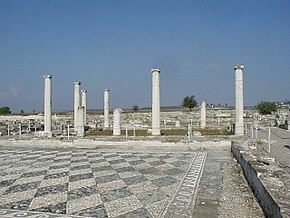
However, the local form of Greek was not
Doric, and the word exactly matches standard Greek pélla “stone”,
undoubtedly referring to a famous landmark from the time of its foundation.

The
city was founded by Archelaus I of Macedon (413–399 BC) as the capital of his
kingdom, replacing the older palace-city of Aigai (Vergina). After this, it was
the seat of King Philip II of Macedon and of Alexander the Great, his son. In
168 BC, it was sacked by the Romans, and its treasury transported to Rome.
Later, the city was destroyed by an earthquake and eventually was rebuilt over
its ruins. By 180 AD, Lucian could describe it in passing as “now insignificant,
with very few inhabitants”.
Julia
Avita Mamaea (14 or 29 August after 180–235) was the second daughter of
Julia
Maesa
, a powerful
 Roman woman of Syrian
Roman woman of Syrian
Arab
origin and Syrian noble
Julius Avitus
. She was a niece of empress
Julia
Domna
and
emperor
Septimius Severus
and sister of
Julia Soaemias
. She was born and raised in
Emesa
(modern
Homs
, Syria
).
Julia’s first husband was a former consul (whose name is unknown) who died.
Julia married as her second husband Syrian
Promagistrate
Marcus Julius Gessius Marcianus
. Julia bore Marcianus two children, a
daughter called Theoclia (little is known of her) and a son, Marcus Julius
Gessius Bassianus Alexianus, later emperor
Alexander Severus
. Unlike her sister, Julia Mamaea was reported to be a
virtuous woman, never involved in scandals.
As a member of the Imperial Roman family, she watched closely the death of
her cousin Caracalla
and the ascent to power of her nephew
Elagabalus
,
the oldest grandson of Julia Maesa and her choice to the throne. Eventually
Elagabalus and his mother Julia Soaemias proved incompetent rulers and favour
fell on Alexander, Julia’s son. He became emperor in 222, following Elagabalus’
murder by the
Praetorian Guard
. Julia and her mother became regents in the name of
Alexander, then 14 years old. Upon adulthood, Alexander confirmed his esteem for
his mother and named her consors imperii (imperial consort). It was in
this condition that she accompanied her son in his campaigns: a custom started
with Julia Domna
. Thus she travelled to the East, for the campaign against
Parthia
and
to the Germania provinces. Julia Mamaea was with Alexander in Moguntiacum
(modern Mainz
),
capital of
Germania Superior
, when he was assassinated by his troops. She suffered the
same fate.
In the
material culture
of
classical antiquity
, a phiale or
patera (Latin pronunciation: [ˈpatera])
is a shallow ceramic or metal
libation
bowl. It often has a bulbous
indentation (omphalos,
“bellybutton”) in the center underside to facilitate holding it, in which case
it is sometimes called a mesomphalic phiale. It typically has no handles,
and no feet. (A drinking cup with handles is a
kylix
. A circular platter with a pair of
C-handles is not a patera, but a few paterae have a single long straight
handle.) Although the two terms may be used interchangeably, particularly in the
context of
Etruscan culture
, phiale is more common
in reference to Greek forms, and patera in a Roman setting.
-
 Silver phiale (620-590 BC, from
Silver phiale (620-590 BC, from
Bayindir
village,
Elmali
, present-day Turkey -
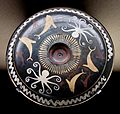 Octopus and dolphin motifs on a ceramic phiale (510–500 BC, from
Octopus and dolphin motifs on a ceramic phiale (510–500 BC, from
Eretria
,
Euboea
) -
Golden phiale (4th–3rd century BC) -
_01.jpg/117px-Pátera_ibera_de_Perotito_(M.A.N._1917-39-1)_01.jpg) Silver patera from
Silver patera from
Hispania
(Roman
Spain), 2nd–1st century BC)
Use

naiskos
, a scene that may also
represent
Ganymede
serving
Zeus
(Apulian
red-figure
krater
, 340–320 BC)
Libation was a central and vital aspect of
ancient Greek religion
, and one of the simplest
and most common forms of religious practice. It is one of the basic religious
acts that define piety in ancient Greece, dating back to the
Bronze Age
and even
prehistoric Greece
. Libations were a part of
daily life, and the pious might perform them every day in the morning and
evening, as well as to begin meals. A libation most often consisted of mixed
wine and water, but could also be unmixed wine, honey, oil, water, or milk.
The form of libation called spondē is typically the ritualized pouring
of wine from a jug or bowl held in the hand. The most common ritual was to pour
the liquid from an
oinochoē
(wine jug) into a phiale. Libation
generally accompanied prayer. The Greeks stood when they prayed, either with
their arms uplifted, or in the act of libation with the right arm extended to
hold the phiale. After the wine offering was poured from the phiale, the
remainder of the contents was drunk by the celebrant.
In Roman art
, the libation is shown performed at
an
altar, mensa (sacrificial meal table)
,
or
tripod
. It was the simplest form of sacrifice,
and could be a sufficient offering by itself. The introductory rite
(praefatio) to an animal sacrifice included an incense and wine libation
onto a burning altar. Both
emperors
and divinities are frequently
depicted, especially on coins, pouring libations from a patera. Scenes of
libation and the patera itself commonly signify the quality of
pietas
, religious duty or reverence.
-
 Libation at a
Libation at a
symposium
(Attic
red-figure cup, ca. 480 BC) -
 Apollo pouring a libation (Attic
Apollo pouring a libation (Attic
white-groundkylix
, ca. 460 BC) -
 Etruscan priest with phiale (2nd century BC)
Etruscan priest with phiale (2nd century BC) -
 Roman priest,
Roman priest,
capite velato
(2nd–3rd century
AD)
|
|
|
Frequently Asked Questions How long until my order is shipped? shipment of your order after the receipt of payment. How will I know when the order was shipped? date should be used as a basis of estimating an arrival date. After you shipped the order, how long will the mail take? international shipping times cannot be estimated as they vary from country to country. I am not responsible for any USPS delivery delays, especially for an international package. What is a certificate of authenticity and what guarantees do you give that the item is authentic? and a Lifetime Guarantee of Authenticity, issued by a world-renowned numismatic and antique expert that has identified over 10000 ancient coins and has provided them with the same guarantee. You will be quite happy with what you get with the COA; a professional presentation of the coin, with all of the relevant information and a picture of the coin you saw in the listing. Compared to other certification companies, the certificate of authenticity is a $25-50 value. So buy a coin today and own a piece of history, guaranteed. Is there a money back guarantee? I offer a 30 day unconditional money back guarantee. I stand behind my coins and would be willing to exchange your order for either store credit towards other coins, or refund, minus shipping expenses, within 30 days from the receipt of your order. My goal is to have the returning customers for a lifetime, and I am so sure in my coins, their authenticity, numismatic value and beauty, I can offer such a guarantee. Is there a number I can call you with questions about my order?
You can contact me directly via ask seller a question and request my telephone number, or go to my About Me Page to get my contact information only in regards to items purchased on eBay. When should I leave feedback? order, please leave a positive. Please don’t leave any negative feedbacks, as it happens many times that people rush to leave feedback before letting sufficient time for the order to arrive. Also, if you sent an email, make sure to check for my reply in your messages before claiming that you didn’t receive a response. The matter of fact is that any issues can be resolved, as reputation is most important to me. My goal is to provide superior products and quality of service. |







